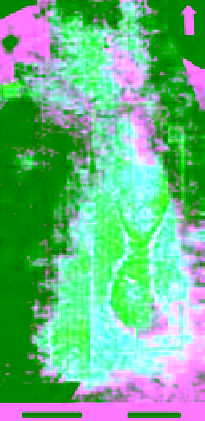Geoscience Reference
In-Depth Information
(A)
(B)
Seismic Facies Correlation Maps
To p Res Horizon Slice
Seismic Facies Classification Map
N
N
N
N
10 km
10 km
10 km
30 km
Fig. 11.
(A) Seismic amplitude map illustrating the reservoir fairway of the Egga sandstone unit in the Ormen Lange
subbasin. Note presence of ribbon-like features across depocentres in southern and northern part of the field (see also
Fig. 11B) as well as extending towards the west into the adjacent downslope subbasin. These features probably represent
low-sinuosity channel fills and fairways. Irregular to rounded margins of outer fairway is attributed to distal pinch- or
shale-out of individual lobe storeys and complexes. The map represents partially transparent seismic amplitudes over a
window covering the upper parts of the Danian reservoir play. The rate of transparency is gradually changing from less
transparent on the positive amplitudes (red), to more transparent on the negative amplitudes (black). This methodology
utilises the Shell proprietary 'Seismic Sculptor' software and is especially useful for visualisation and enhancements of
laterally varying depositional patterns and geometries, such as seen for the Danian turbidite fairway (Egga Mbr) on Ormen
Lange. (B) Seismic facies correlation map, top reservoir horizon slice semblance map and seismic facies classification
maps. The seismic facies classification, correlation and horizon slices suggest lateral thickness and facies variations across
the Ormen Lange field, with thicker and sandier facies representing two depocentres in the northern and southern parts of
the field, respectively. Note however the strong imprint of fluid contact inhibiting direct correlation of seismic facies and
amplitudes within to outside the Ormen Lange field area.
bounding surface, normally suggesting a broader
and lower relief, convex upwards geometry of indi-
vidual bedset motifs.
The Lobe Fringe association consists of isolated,
thin-bedded to medium-bedded, incomplete (base-
absent or top-absent) Bouma-type T
abcd
turbidite
beds, embedded in turbiditic and hemipelagic mud-
stones (Table 3). A gradational transition occurs from
the near absence of turbidite beds (translational into
the background turbiditic mudstone association) to
well-layered packages of predominantly medium-
bedded T
abcd
and T
bcd
turbidites alternating with
background mudstone facies. The background facies
of this association consists of nearly equal amounts
of turbiditic and hemipelagic mudstones, as well as
commonly abundant contouritic mudstones. The
component facies and thinness of the interbedded
sandstones in consort with the high proportion of
background mudstones, is typical for deposit for the
outermost parts of turbidite lobes (e.g. Twichell
et al
., 1995; Johnson
et al
., 2001; Remacha &
Fernandez, 2003; Janocko, 2008; Prélat
et al
., 2009;
Marini
et al
., 2011). This association is accordingly
interpreted to represent marginal and distal lobe
fringe deposits.
The Megabed association consists of layered pack-
ages of massive sandstones, deformed (sheared) and
slumped sandstones, some stratified sandstones and
rare Bouma-type T
abc
turbidites (Table 3; Fig. 8C).
Inter-well correlations of the massive sandstone
beds are poor, suggesting limited lateral extent to the
individual beds. The sandstone facies alternates
with turbiditic, hemipelagic as well as pelagic
mudstones and claystones, locally with sandstone
injections or sandstone dikes cross-cutting mudstone
laminations. This association represents rare incur-
sions of event-type beds of predominantly debris
flows origin (Lowe, 1979, 1982; Shanmugam, 2000)


Search WWH ::

Custom Search